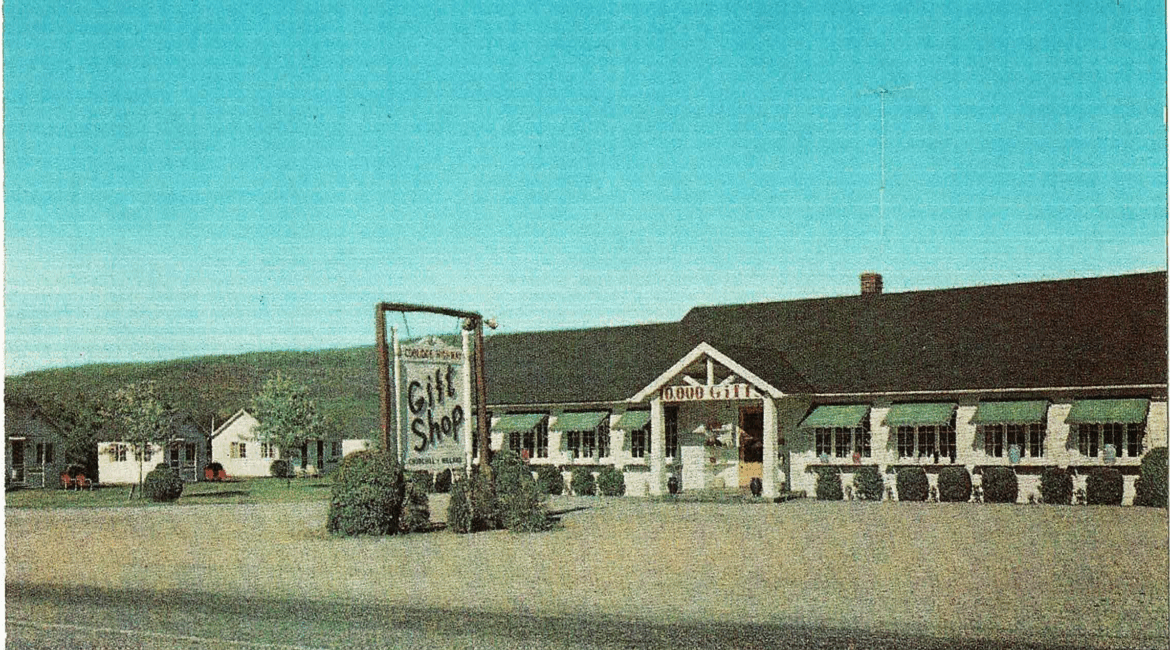Over the course of many years, travelers entering the Brattleboro North KOA Dummerston, VT campground have looked forward to a camping site for their RV or camp trailer while others anticipate spending a night or two in one of the cozy overnight cottages on the beautifully maintained eight-acre property with a scenic view of the New Hampshire hills in the background.
The campground reflects a legacy of the automobile age and a series of events going back to colonial times when Charles Davenport first occupied the property as the original owner with access to the “Connecticut River Road” used by Indians and settlers alike. By 1919, ownership had passed to J.E. Walker whose descendants still operate the Walker Farm to the south of the campground. At this time, the western edge of the present campground extended 150 feet further west as farmland to the edge of the “Connecticut River Road.” A major change in American culture reflecting the automobile age led to a change in land use for the site now occupied by the Brattleboro North KOA campground.
The “lure of the American road” culminated in a huge new industry being established along the nation’s highways to satisfy the needs of the automobile age. By 1900, travel by automobile was displacing travel by rail with overnight stays in city hotels. People traveling by car sought freedom from city habits including wearing “proper dress” to formal hotel dining rooms. The car allowed a more relaxed mode of travel, but finding overnight accommodations beyond city limits as the sun was setting became a challenge. Many pitched tents along the road and caused conflicts with property owners, while others sought guest houses offering meals and a decent bed. By 1920, between 3,000 and 6,000 municipal auto-camps had been established nationwide to alleviate trespassing on private property along well-travelled roads. Entry was free and “facilities” included grills, fresh water, and privies. A rule of thumb at the time was an average small town camp on a main road could expect 50 to 60 cars a day.
As the numbers grew larger and the public auto-camps became rowdier, private enterprise took notice, with farmers constructing barely livable cabins on empty parcels of property along the road to supplement their incomes. These early roadside cabins gave way to well-appointed overnight cottages offering comfortable beds, heat, bathrooms and attractive exteriors with roadside appeal located on a small drive or semicircle with ample parking: in essence the “motor court.” The transition from simple roadside cabin to motor court cottage was the legacy of the motor court era which morphed into the motel industry.
Timeline of Key Events:
- 1770 – Charles Davenport is original owner.
- 1919 – Property has been conveyed to J.E. Walker and used as farmland.
- 1920 – Property has been conveyed to Ellen Fitts Manley.
- 1922 – “Connecticut River Road” reconstructed under Federal Aid Project No. 14 (unpaved); becomes Vermont State Highway Route 2, part of the New England Road Marking System, renamed “Connecticut River Way.”
- 1927 – Route 2 becomes U.S. Route 5 after national realignment; becomes a major scenic and historic drive through New England.
- 1933 – U.S. Route 5 surfaced with oiled gravel.
- 1937 – Due to increased traffic and accidents on the Dummerston section, a project is initiated to relocate the road from Northeast Pines State Park to School House Road intersection. Includes rock cut opposite Walker Farm; old road still visible.
- 1939 – New U.S. Route 5 constructed on the west side of future gift shop property. East West Road extended. New road made of reinforced concrete (24 ft wide + 6 ft shoulders), replacing dangerous road section with reverse curves and steep grades.
- 1939 – U.S. Route 5 renamed the Calvin Coolidge Memorial Highway.
- 1941 – Ralph and Mabel Churchill purchase 8 acres from Ellen Fitts Manley. They construct and open the Coolidge Highway Gift Shop with high-end Vermont souvenirs and handmade crafts.
- 1943 – Gift shop temporarily closes due to WWII gasoline rationing.
- 1945 – Gift shop reopens post-war as traffic increases.
- 1949 – Lovisa and Richard Willard (Churchill’s daughter and husband) buy 50% interest. Four cabins built (wood stoves, no bathrooms—guests use Gift Shop).
- 1950 – Fifth cabin added; second floor built onto Gift Shop.
- Dick Perry opens narrow gauge circular amusement railroad behind Gift Shop (rides 25 cents). Wooden bridge built for access.
- 1955 – Churchills retire; Willards purchase full business. Cabins updated with bathrooms.
- 1956 – Interstate Highway Act passed by Congress, creating future threat to local business due to I-91.
- 1961 – Interstate 91 opens through Dummerston on December 6. Traffic on U.S. Route 5 sharply declines.
- 1968 – Decline in business leads the Willards to seek new use for back portion of property.
- 1971 – Willards open Brattleboro North KOA campground on rear property under franchise with Kampgrounds of America, Inc.
- Campground includes 41 sites, utility hookups, A-frame lounge/restroom with TV and games.
- 1977 – Richard Willard appointed Postmaster of Putney, VT.
- Willards sell business to Lyn and Ronald Wright. Their daughters Wendy and Kelly help operate it.
- 2007 – Campground sold to Balanced Rock Corp.
- Operated by Beverly, Ernest, and Justin Kenney.
- Improvements include: larger swimming pool, log cabin, computer/Wi-Fi access, weekend family activities.
- 2019 – Campground sold to BertaVenture LLC; operated by the Berta family
Acknowledgements:
Beverly and Ernest Kenney
Brattleboro Public Library
Dummerston Historical Society
Dummerston Town Clerk’s Office (Pamela McFadden, Laurie Frechette)
Vermont Agency of Transportation District 2 (Nelson Blanchard)
The Walker Farm (Jack Mannix)
Neighbor Bob Evans
